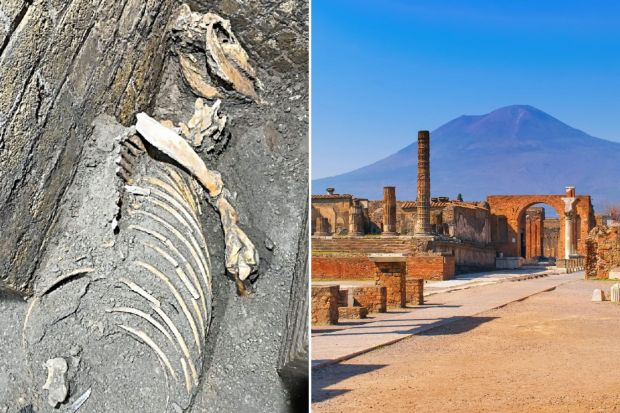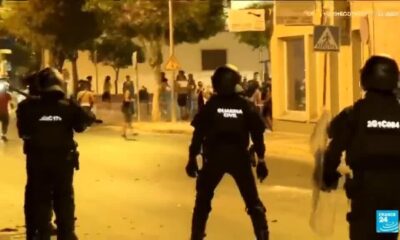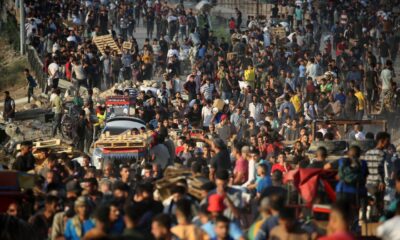Science
New Evidence Shows Romans Returned to Pompeii After Eruption

Recent archaeological discoveries have unveiled that Romans returned to the devastated city of Pompeii nearly two thousand years after the catastrophic eruption of Mount Vesuvius in 79 AD. This revelation challenges previous assumptions about the city’s aftermath, providing a compelling narrative about life in the ruins.
Until now, it was largely believed that the eruption resulted in a complete abandonment of Pompeii. The event, which killed thousands, left the city buried under layers of ash and rubble. Many historians speculated that any survivors had fled and never returned. However, new findings suggest that some residents did come back, albeit under significantly altered circumstances.
Archaeologists have identified evidence indicating that those who returned were primarily from the poorer segments of society. These individuals, unable to afford new homes elsewhere, sought to reclaim whatever valuables they could find among the debris left behind by wealthier citizens. The upper floors of some structures, which remained standing, saw a return to habitation, while the ground floors were transformed into makeshift cellars equipped with ovens and mills.
Gabriel Zuchtriegel, the director of the Pompeii Archaeological Park, noted, “Thanks to the new excavations, the picture is now clearer: post-79 Pompeii reemerges, less as a city than as a precarious and grey agglomeration, a kind of camp, a favela among the still-recognisable ruins of the Pompeii that once was.” His statement highlights the evolution of the site from a bustling city to a more informal settlement in the centuries following the eruption.
Previously, evidence of this reoccupation was overlooked during excavations, as the focus remained on the vibrant frescoes and intact structures. Zuchtriegel emphasized that the traces of the site’s later use were often “swept away without any documentation.” He also remarked on the overshadowing memory of the city’s destruction in 79 AD, which has long dominated historical narratives.
The significance of these findings suggests that Pompeii functioned as an informal settlement until at least the 5th century. While the exact death toll remains uncertain, estimates indicate that between 15% and 20% of the city’s population perished in the eruption. Many fatalities resulted from thermal shock caused by the volcanic ash and gases that engulfed the city.
The destruction of Pompeii is a pivotal moment in history. Located near modern-day Naples in the Campania region of Italy, Pompeii, along with Herculaneum and surrounding villas, was buried under volcanic ash during the eruption. The thermal energy released from Vesuvius was estimated to be a hundred thousand times greater than the atomic bombs dropped on Hiroshima and Nagasaki.
After being lost for approximately 1,500 years, the site was rediscovered in 1599, with broader excavations commencing in the subsequent century. The preservation of the remains beneath the ash layers has provided unique insights into Roman life. Archaeologists have used plaster to fill voids where human bodies once lay, allowing for the recreation of their final positions during the eruption.
Mount Vesuvius remains a significant threat, classified as one of the most dangerous volcanoes worldwide. Despite a period of dormancy lasting nearly a century, it erupted approximately three dozen times since the destruction of Pompeii, with the most recent eruption occurring in 1944. Currently, about three million people live in close proximity to the volcano, which experts classify as “extremely active” and unpredictable.
Recent excavations have continued to yield new findings, including the discovery of skeletal remains, which provide further evidence of the human impact of the eruption. In February, archaeologists uncovered the remains of a child in a crouched position, a tragic reminder of the eruption’s devastating effects.
The ongoing research at Pompeii not only sheds light on the immediate aftermath of the eruption but also enriches our understanding of life in the city during the centuries that followed, highlighting the resilience and adaptability of its inhabitants in the face of disaster.
-

 Entertainment1 week ago
Entertainment1 week agoAimee Osbourne Joins Family for Emotional Tribute to Ozzy
-

 Politics2 weeks ago
Politics2 weeks agoDanny Healy-Rae Considers Complaint After Altercation with Garda
-

 Top Stories3 weeks ago
Top Stories3 weeks agoFianna Fáil TDs Urgently Consider Maire Geoghegan-Quinn for Presidency
-

 World3 weeks ago
World3 weeks agoHawaii Commemorates 80 Years Since Hiroshima Bombing with Ceremony
-

 World3 weeks ago
World3 weeks agoGaza Aid Distribution Tragedy: 20 Killed Amid Ongoing Violence
-

 World3 weeks ago
World3 weeks agoCouple Convicted of Murdering Two-Year-Old Grandson in Wales
-

 Top Stories4 weeks ago
Top Stories4 weeks agoClashes Erupt Between Far-Right Groups and Migrants in Spain
-

 World4 weeks ago
World4 weeks agoAristocrat Constance Marten and Partner Convicted of Infant Murder
-

 Top Stories3 weeks ago
Top Stories3 weeks agoHistoric Dalkey Pub The Queens Reopens Under New Management
-

 World3 weeks ago
World3 weeks agoTrump Defends FBI Deputy Director Amid Epstein Files Controversy
-

 Business4 weeks ago
Business4 weeks agoSunshine 106.8 Boosts Irish Music After Regulator’s Request
-

 Politics3 weeks ago
Politics3 weeks agoTragic Crowd Surge at Gaza Aid Center Claims 20 Lives









